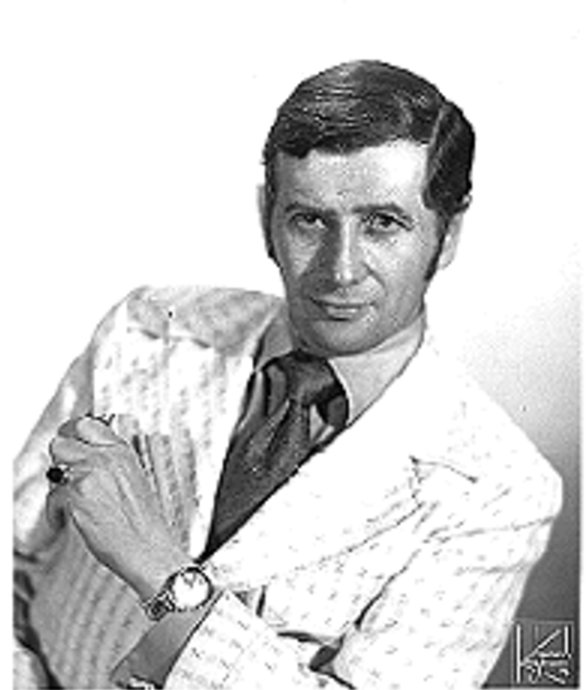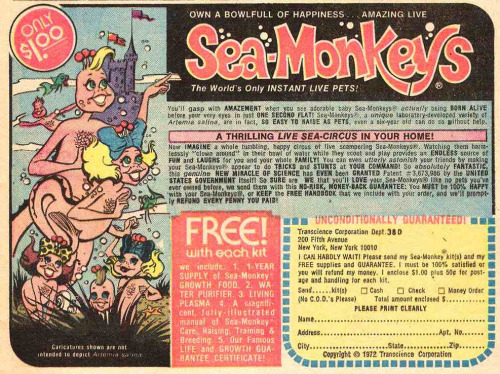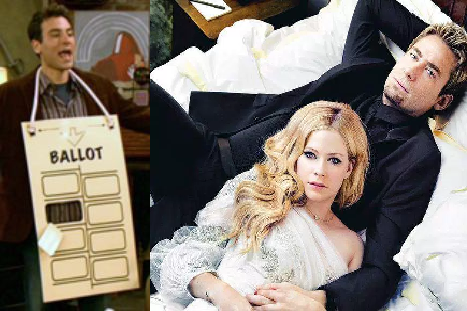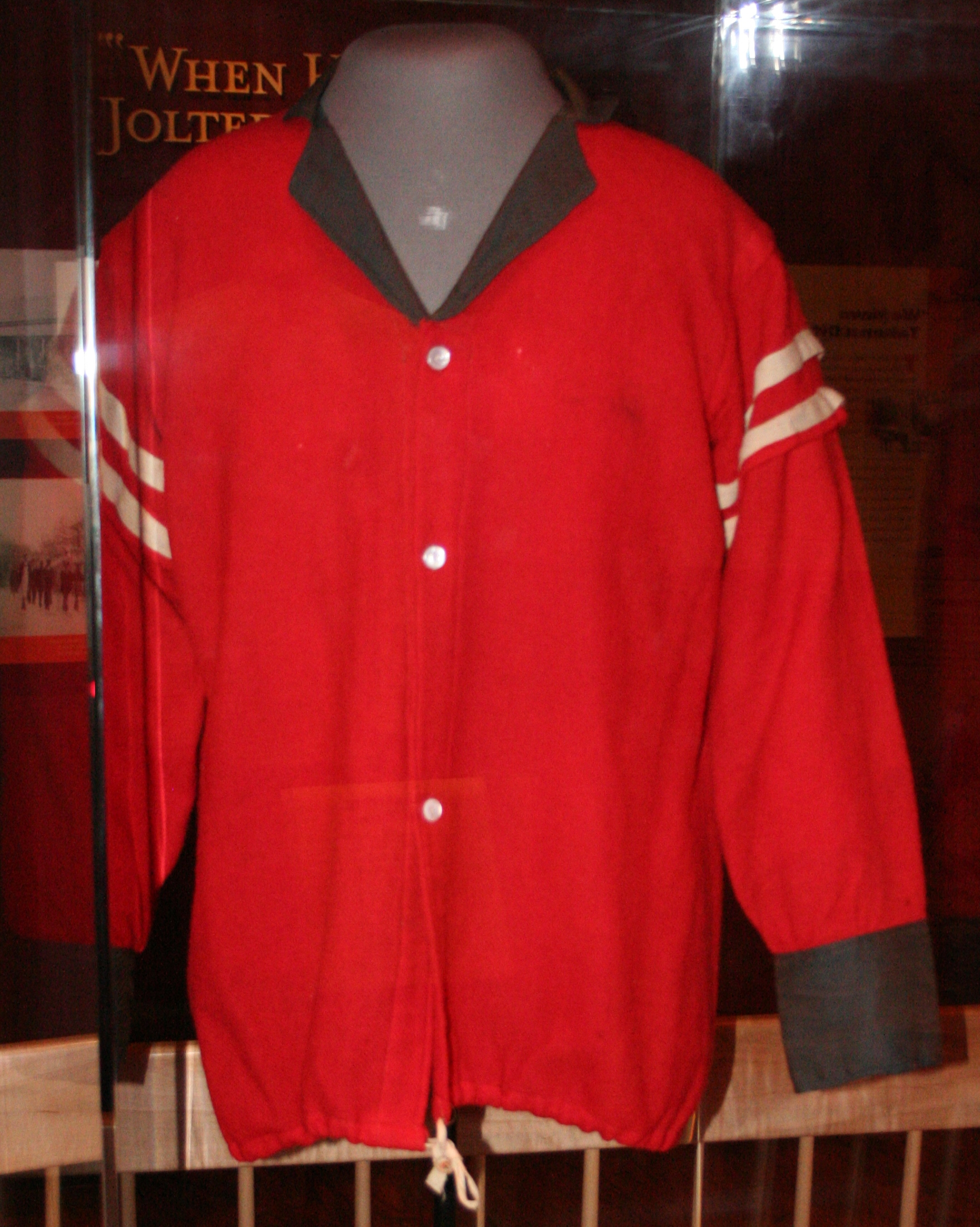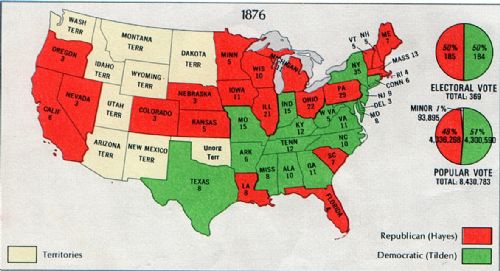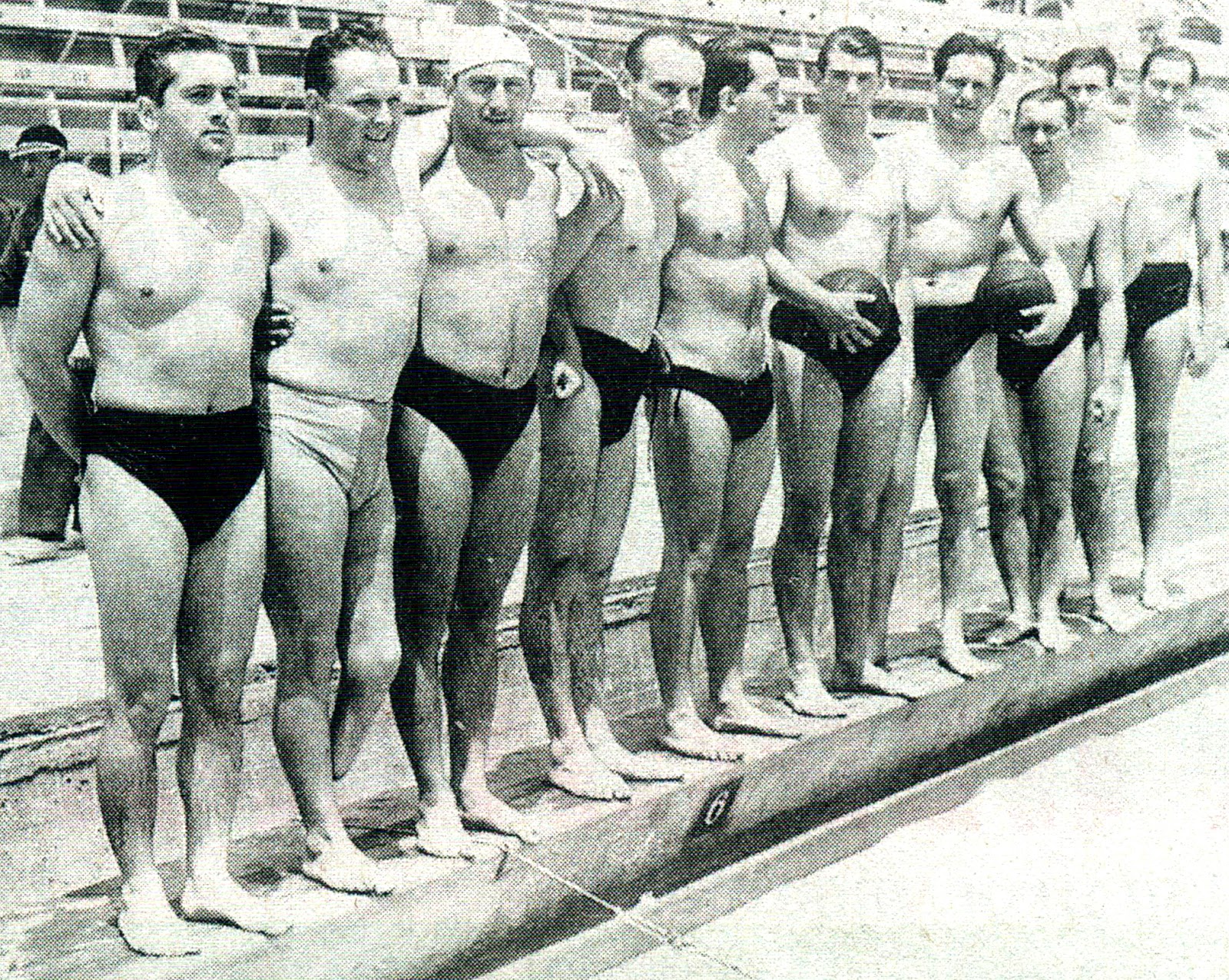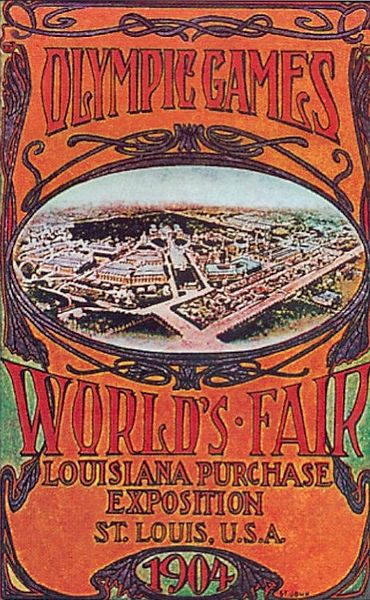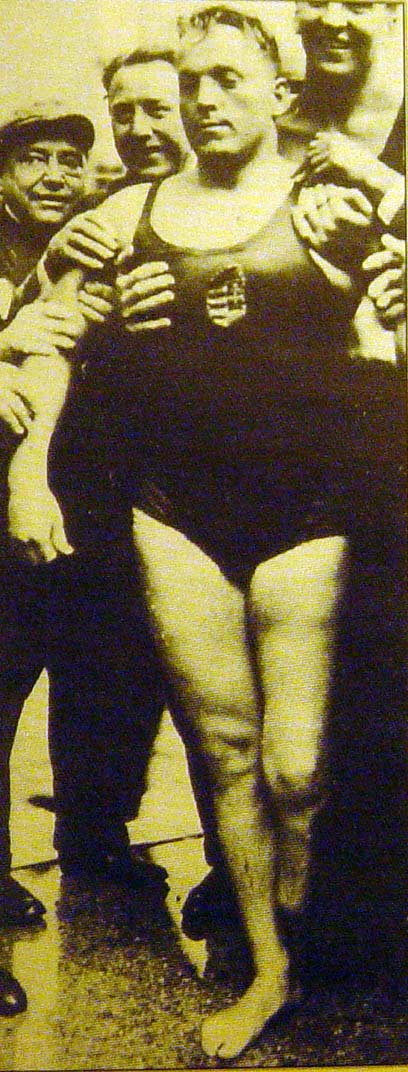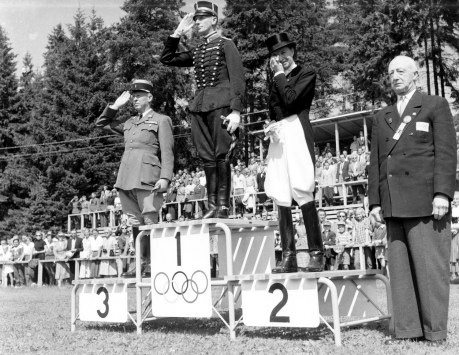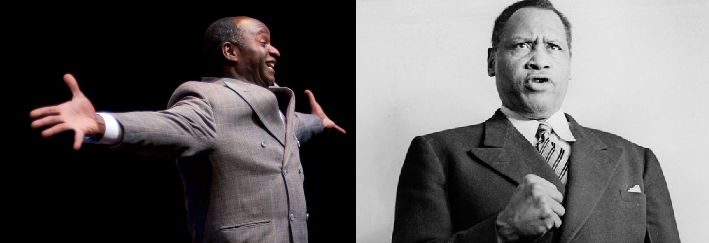Sea monkeys were so big even the Simpsons did them (and South Park, and Arthur…) That the USA’s most famous family paid homage to the postbox pets, well after their heyday, shows how enshrined in pop culture this odd little hobby became.
Like many 20th century American kids, Bart loved ordering junk out the back of comic books (where’s my spy camera?) junk that would take weeks to be delivered, building up anticipation (WHERE’S MY SPY CAMERA?) before arriving, underwhelming. Harold von Braunhut’s Amazing Sea-MonkeysⓇ were the queens of this trade. But, behind the cultural phenomenon was an inventor who funnelled his time and money into far-right activity, and did so with the broad consent of US business. The story of the sea monkeys is much like the little shrimps’ reveal to the once-excited child – what was really in the package is unlike anything you’d thought it would be.

Sea-MonkeysⓇ are brine shrimp, with a genetic twist. As the name suggests, they really like salt. Anyone who has ever kept fish know that fish really like to eat them. They aren’t particularly eye-catching or entertaining, though that is largely because they are miniscule. Those big enough to see resemble writhing skeletons. So how on earth did they become a thing?
RING TOSS
Like most US traditions, you can find your answer in the carnival and the comic book. As Jack Hitt wrote in the NYT, sea monkeys were soaked in the art of humbug. Harold von Braunhut was not a carny, but was a savant in its methods. “What made Braunhut’s work so edgy, so American,” Hitt said, with astonishment nearing on admiration, “was how wickedly far he’d journey – far past the product itself, into the fictional.” Von Braunhut had learned much from sideshow entertainment during his time racing motorbikes as the Green Hornet, dabbling in magic, and representing a mentalist whose act was to dive off a high platform into a 1ft deep pool. In his younger days, Harold hobnobbed with daredevils, tricksters, hucksters and cheats, getting where water could not, always looking for the next big idea.
His next swindle lay in the booming post-war market of children’s toys. Victory in war had led to babies – lots of them, and US businesses were on a mission to turn them into tiny consumers (or tiny marks). Things were on sale wherever kids looked, and if you could get them to buy whilst their parents weren’t looking, you could make an honest buck.

Nowadays, we know all about how advertising can lead to us owning a host of mass-produced crap we didn’t want. But von Braunhut was an early exponent, and his secret weapons were the great Carnival tricks of humbug and illusion. One of his most infamous hoodwinks was “X-Ray Specs,” marketed hard at the perverts of tomorrow, promising pubescent boys the chance to see through women’s garments. Of course, they were just cheap blurry glasses.
Better yet, there was the “Invisible Fish (Do Not Feed)”, which involved von Braunhut literally selling a big bag of nothing to kids. But magic relies on both the show and the audience believing what everybody really knows isn’t true. Most kids (I hope) knew on some level that their purchases were phony. But so was a Buzz Lightyear or a Tracy Island set – von Braunhut’s wares were toys, and it was the marketing that sparked imagination and enjoyment, so long as no-one broke the spell with a “You know it’s fake” reveal.
INSTANT LIFE
Von Braunhut, however, knew that to truly siphon away America’s pocket money, he needed to flog something a little more tangible than the invisible goldfish. The greatest humbugs, after all, have a grain of truth at their heart that hooks the mark. He needed something real that could inspire imagination, that had just enough about it to compliment a marketing campaign and go universal. Inspiration came from Uncle Milton’s Ant Farms, which promised children a micro-civilisation of pets in their own bedroom, at a reasonable cost.

Von Braunhut aimed to go one better with his new product, “Instant Life.” He came across across the humble brine shrimp, who made their home in harsh salt lakes. The shrimp’s eggs had adapted to their hostile homes by developing the ability to lie without oxygen – essentially in suspended animation – for years, waiting for the arrival of briny water in which to hatch, in a process known as cryptobiosis, or “hidden life.”
The idea was this – sell the static eggs in packets that also contained powder that salted the water enough for the shrimp to hatch, and – hey presto – Instant Life. Children of America – you have the power to play God for just a dollar 25!
Two problems stood in von Braunhut’s way. Firstly, brine shrimp are weird. Children wouldn’t have any idea what they were creating. These skeletal, diminutive shrimp weren’t “life” in a familiar way as, say, ants were. The second issue was that the concept had already been discredited by the Wham-O toys debacle just months earlier. Like von Braunhut, Wham-O were inspired by the potential wonders of creating life itself, and settled on breeding a type of African Killifish as their product. The eggs of this fish used a similar process to the brine shrimp to wait out the dry season. Trouble was, this fish – a complex vertebrate highly entuned to its environment – did not produce enough eggs to fulfil the sales promised to investors, and those that appeared were very difficult to hatch, and even more difficult to keep alive. It was a disaster.
No promoter would dare touch “Instant Life” after this debacle, so von Braunhut turned to the back pages of comic books to market them himself. That way he could go straight to his marks – children – without retailers and parents getting in their way with logic and the cautionary tale of Instant Fish. Both the product and the message needed improvement, however, before kids would start emptying their piggy banks into von Braunhut’s open palms. Brine shrimp were underwhelming enough as it was; they’d disappoint even more if they all dropped dead before they grew large enough to see. As it stood, this was just Invisible Fish but with a bigger comedown.
SHRIMP, JIM, BUT NOT AS WE KNOW IT
Von Braunhut transformed the toy with three important changes. The first aimed to make the shrimp live longer, and so he and biologist Anthony D’Agnostino termed up to create some new life themselves. Through selective breeding, they developed a new type of brine shrimp that was more likely to survive cryptobiosis and live longer in an artificial environment. The new species was named Artemis NYOS, after the New York Oceanic Society, whose laboratory they used.
Alongside, they changed the set-up procedure so that two sachets were included, mislabelled in a sleight-of-hand bi-proxy to enable the illusion. The first sachet, named “water purifier”, promised to precondition the tap water, but it also contained eggs. The second sachet, named “Instant Life”, did contain some (more) eggs but its most important ingredient was a dye that amplified the existing shrimp, making them visible within a minute, and “thereby giving the impression” (as the patent read) that they appeared as if by magic. Instant life.
Clockwise from top-left: Harold von Braunhut (source: Mental Floss), Dr Anthony D’Agnostino (East Hampton Star), Joe Orlando (Wikipedia), & Yolanda Signorelli (NYT)
The last change was the most decisive, and saw von Braunhut once more team up with a specialist; this time, a master of comic design. Joe Orlando would later take leading roles in both DC Comics and MAD Magazine, but made his name building the sea monkey lore. The word “shrimp” would not be uttered again, for these aren’t shrimp, they are Monkeys of the Sea – tiny intelligent creatures who got up to all sorts of adventures; they were just too small to see what exactly they were.
Von Braunhut and Orlando took the elongated tails of Artemia NYOS as their grain of truth. It could be said, with a leap of faith, that they resembled a monkey’s tail. That was enough. From there, Orlando birthed anthropomorphic cartoon characters that had elements of primate, fish and sea monster, but also took notes from Hannah-Barbara. In the era of the Flintstones and the Jetsons, it did not take much imagination to envisage a tiny family at the bottom of the sea that cavorted and capered its way through life.
This was the ingenuity of the marketing strategy – you could see the sea monkeys and you could see their tails. You could also see the characters on the box. What you couldn’t perceive, due to their size and the underwater barrier, is what they were up to in the tank. That’s when the imagination kicked in. “I think kids are pretty clever at finding ways to have fun,” said Patricia Hogan, of the Strong National Museum of Play, to Mental Floss, “even with something that may disappoint them because they’re not exactly as they appeared.” Von Braunhut encouraged this by next flogging a myriad of accessories and add-ons with which the sea monkeys could make their adventures, such as the “Aquatic Speedway,” which he patented in 1973.
The Amazing Sea-MonkeysⓇ were a hit. The money started streaming in, as wave after wave of brine shrimp travelled to (and quickly perished in) millions of American homes, lasting just long enough in their tiny tanks to make an impression upon a whole generation.
Sea-MonkeysⓇ past and present (Source: Mental Floss)
ENTER THE NAZIS
Harold von Braunhut was now rolling in it like Scrooge McDuck. He and his new wife, the ’60s bondage film star Yolanda Signorelli, moved into a sprawling ranch south of DC, which they started turning into a wildlife reserve with part of the sea monkey fortune. Some of the rest, however, soon found its way into the coffers of the far-right.
Many sea monkeys info pages note this connection as a quirk of von Braunhut himself – an example of the lore of mad scientist inventors – while Hitt notes it as the thing that denied him everlasting glory in the annals of American business. Few, however, really explore how the business world’s enduring consent, amidst von Braunhut’s unceasing far-right activity, allowed the inventor to still fill fascist coffers with sea monkey profits.
It’s unclear when Harold von Braunhut started funding Neo-Nazis, but his affiliation with the Aryan Nations (AN) alone certainly spanned decades. Notably, he was born not with “von” in the middle of his name but with Nathan; Harold was born Jewish. In later life he told a reporter that he changed it to make his name sound more German. Von Braunhut’s concerning connections first came to the attention of the American media in 1979 when he was arrested trying to board a flight with one of his 193 patents – an item, it transpired, he was advertising in far-right publications. Sadly, it wasn’t Invisible Fish. It was a weapon.

USP 3554546, the “Spring Whip Defensive Weapon,” was a spring-loaded baton that wielded enough force to incapacitate – von Braunhut marketed it to the AN for “if you need a gun but can’t get a license.” The K5, as it became known, was no parlour trick (it worked) but instead a chilling reveal of for whom this weapon was designed. It was also no one-off; von Braunhut updated the patent a few times, and his 1984 edition included the justification “that the need for defensive weapons continues to rise with the crime rate,” particularly chilling as von Braunhut seemed to adhere to Manson’s “Helter Skelter” belief of an impending race war.
Yet von Braunhut’s reputation went unharmed, however, until 1988 when the AN encouraged members to buy the K5, as some of the proceeds would go to the legal fees of AN leader Richard Butler, who was facing trial for the minor infraction of sedition (inciting insurrection). Following the trail, the Washington Post released an exposé of von Braunhut’s past and present, revealing a $12k loan he gave to the KKK in 1985 so a Grand Wizard could buy 83 guns, and his Jewish origins. The Nazis, for the most part, weren’t fussed about the latter, so long as he kept supporting them. Elsewhere, the Amazing Sea-MonkeysⓇ partners Larami continued to market and distribute the product, despite public outcry.
SEE NO EVIL
Nothing changed. This was Reagan’s America after all, where no hateful affiliations need get in the way of a good profit. In fact, if anything, in the early 1990s, sea monkeys underwent a revival. The original duped children were now adults, and many decided to passed on the tradition with their own kids. Some felt like it was a strong part of their youth they wished to share with their progeny; others? Maybe they thought it worked well as a lesson that life is full of disappointment.
Other members of that generation – now in the creative industries – started stocking sea monkeys back into pop culture as nostalgic throwbacks to their youth. Nobody did this better (worse) than Howie Mandel, who produced a TV show called Amazing Live Sea Monkeys. The plot was excruciatingly early-90s – a trio of sea monkeys (of the advertised variety) are ripped from their microcosmic underwater life after a mad scientist (played by Mandel) zaps them with a growth ray. It was pitched to the network as “the next Ninja Turtles” in an accidental nod to the shrimp’s humbug origins. The network somehow allowed it to proceed for 11 episodes before canning it.
Meanwhile, von Braunhut continued to support the AN, addressing rallies and meetings on multiple occasions (even “lighting the cross” on at least one visit), and writing nasty, near-genocidal op-eds under the unsubtle and even-more-Germanic moniker Hendrik von Braun. Business continued as normal, but anti-racist campaigners like the Anti-Defamation League worked hard to monitor von Braunhut and pressure his partners. Larami got antsy.
Larami was not known for its strident moral stances, having spent much of the ’80s marketing hyper-realistic water guns of such aesthetic that von Braunhut might have designed himself. New regulations saw them forced to remodel, out of which came the runway success of the Super Soaker. Under increasing pressure, in 1994 Larami stopped distributing Sea-MonkeysⓇ. A cynic may note that Larami only dropped von Braunhut after the soaker went viral. Indeed, von Braunhut himself towed a similar line. However, Al Davis of Larami told the Los Angeles Times in 2000 that he’d confronted von Braunhut on his views, to which the inventor replied “Hitler wasn’t a bad guy. He just received bad press.”
His next supplier, Basic Fun, swiftly dropped Amazing Sea-MonkeysⓇ again because of von Braunhut’s fascism, but he quickly found another. The sea monkeys contract was just too lucrative. Many of von Braunhut’s partners continued to work with him after rectifying their cognitive dissonance, choosing to believe his claim that he was not Hendrik von Braun (whose correspondence address matched that of the Amazing Sea-MonkeysⓇ enquiries address), and his insistence that he was just another guy who’d just received bad press. This series of relationships and rationalisations were documented in detail within another landmark investigation into von Braunhut, this time by Tamar Brott in the LA Times in 2000. Brott pressed one partner on why he believed von Braunhut and he replied “all I know is I have to believe him… Or else how could I live with myself?”
What is remarkable is that it took another groundbreaking journalistic investigation to once again bring von Braunhut’s associations back in the spotlight and that still, despite this, the sea monkeys trade continued to flourish. Harold von Braunhut could not be cancelled and essentially until his death in 2003 some of the profits from his greatest humbug, the sea monkey, lined the pockets of the Aryan Nations, with the broad consent of Corporate America.
PILFERING A LEGACY
The sea monkeys’ association with Neo-Nazism appears to have died with Harold von Braunhut. Yolanda Signorelli von Braunhut has addressed her late-husband’s associations only with silence, but – according to Hitt’s interview with her – she does not appear to share von Braunhut’s active pursuit of far-right causes. Instead, a committed vegan and animal rights campaigner, Signorelli von Braunhut has dedicated herself to the maintenance of the wildlife reserve, and sees the sea monkey as an important way to teach children about the sanctity of all life.
I get this, although a quick read on any sea monkey forum can make you sceptical – some of those shrimp have come to unfortunate ends, from the father who came home thirsty from the pub and accidentally necked a glass of his kid’s sea monkeys, to the guy who thought they might hold the key to the sustainability crisis (they don’t) and started farming them.
After Harold’s death, Signorelli von Braunhut signed a contract with Big Time Toys to market and distribute the sea monkeys. However, in 2013 the toy giant returned to Yolanda and claimed that what she thought was a licensing fee was in fact a down payment on the rights to the Amazing Sea-MonkeysⓇ, and so the Artemia NYOS, the secret “water purifier” and “instant life” powders, and all the legend that went with them, were now property of Big Time Toys. Signorelli von Braunhut responded by refusing to send them anymore of the NYOS shrimp, and then sued them for breach of copyright.

As of January 2020, the case appears to have stagnated – one can only assume it has yet to be settled (apparently there’s a documentary on Signorelli von Braunhut’s struggle in production, suggesting it’s ongoing). Big Time Toys, however, have adapted to the conflict in a manner of which Harold himself might have been proud, were it not against his own grift. Signorelli von Braunhut sued Big Time because they continued to sell Amazing Sea-MonkeysⓇ after she began her embargo; the company started importing masses of regular brine shrimp eggs from China and stuffing them in the sachets instead. Signorelli von Braunhut accused them of selling knock-off products as the real thing.
Big Time responded accordingly. How can we sell something falsely if it does not exist? NYOS are, after all, not one of the seven recognised species of brine shrimp – they aren’t real, and whatever it says on the packet – “hybrid” or “secret formula” or whatever – doesn’t matter – everybody knows it’s only an illusion. Sam Harwell, owner of Big Time, is just being the know-it-all in the playground shouting “the rabbit was in the hat the whole time,” so as to take all the spoils for himself.
SEEING ISN’T BELIEVING
This is how the sea monkeys tale ends. NYOS may die with the von Braunhuts, but it doesn’t matter now. Perhaps Big Time will try and breed their own species, but they don’t seem to care too much whether what they’re selling is any good; it’s only sea monkeys after all, sustained by the nostalgia market, mainly purchased nowadays as pulp presents. The wonder of creating a miniature underwater civilisation is not the draw it once was, for whatever reason (kids these days/video games/cheaper goldfish, who knows). The profits from the imported shrimp will go to Sam Harwell who, for full disclosure, is married to Beth Harwell, a prominent Tennessee Republican politician and avid Trump supporter. If you must buy decorative Artemia, you could instead splurge on one of the myriad of knock-off versions around nowadays – Aqua Dragons, Swamp Monsters, Prehistoric Life – and fund whatever horrid things their owners support.
Of course, you see none of that when you see the box on the store shelf, or the advert in the back of the comic book, or the popup on your browser. You only see the friendly cartoon faces of microscopic sea people, who you can create to cavort and caper for less than $10. That’s the real story of the sea monkeys – from the child blowing their pocket money to von Braunhut’s partners-in-denial – it is whatever you are able to see, and what you believe that to be.

